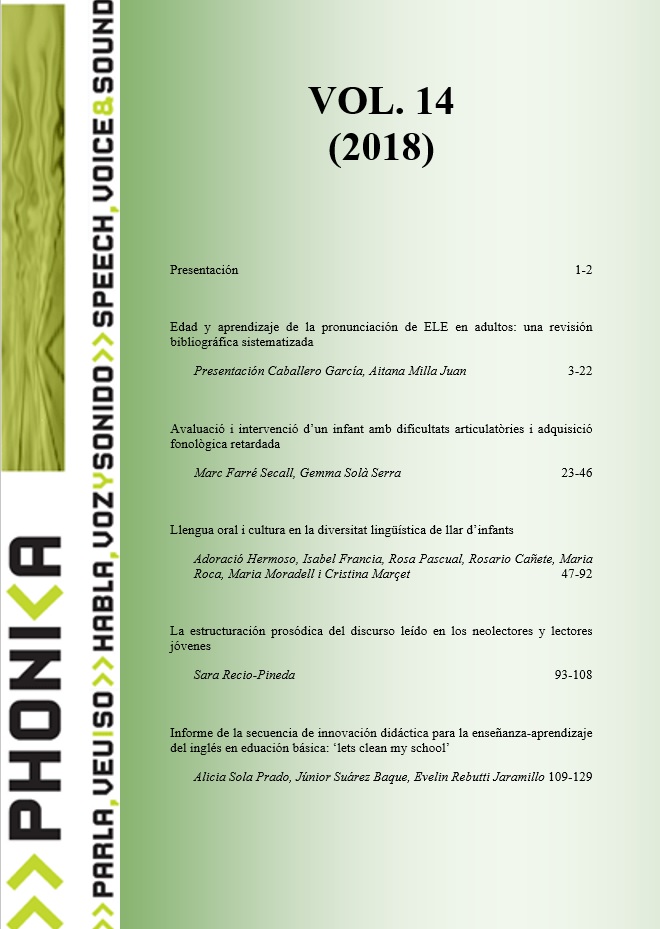Prosodic structure of read speech in new and young readers
DOI:
https://doi.org/10.1344/phonica.2018.14.93-108Keywords:
Prosody, Reading, Elementary School, Phonic Groups, Prelinguistic IntonationAbstract
In this article, we present the results of analyzing the reading prelinguistic intonation of 72 elementary school children (2nd,4th and6th grade) that come from two different public schools of Catalonia and are reading aloud a grade-appropriate narrative text. We explain to what extent their way of structuring the story in phonic groups seeks to package and / or detect the notional-phonetic units of the text. We use a methodology that compares the prosodic strategies of the students with a template that collects and explores the different phonic possibilities of the texts. Results show that prosody is a strategy that is little developed at the age of the participants. In addition, the findings suggest the existence of two different age ranges in prosodic development: the one referring to 2nd graders (in this paper: very young readers) and the one that gathers4th and 6th graders (young readers).References
Allingtion, Richard L. (1983): «Fluency: The neglected reading goal», The Reading teacher, 36. 556-561.
Álvarez-Cañizo, Marta, Paz Suárez-Coalla y Fernando Cuetos (2015): «The Role of Reading Fluency in Children’s Text Comprehension», Frontiers in Psychology, 6, 1810. https://www.ncbi.nlm.nih.gov/pmc/articles/PMC4661265/ [24/07/2018]
Benjamin, Rebekah George y Paula J. Schwanenflugel (2010): «Text Complexity and Oral Reading Prosody in Young Readers», Reading Research Quarterly, 45(4), 388–404.
Cantero, Francisco José (2002): Teoría y análisis de la entonación. Barcelona: Edicions de la Universitat de Barcelona.
Clay, Marie M. y Robert H. Imlach (1971): «Juncture, pitch and stress in reading», Journal of Verbal Learning and Verbal Behavior, 1,133-139.
Daane, Mary C y otros (2005): Fourth-grade students reading aloud: NAEP 2002 Special Study of Oral Reading. (NCES 2006-469). Washington, D.C.: U.S. Department of Education, Institute of Education Sciences, National Center for Education Statistics. https://nces.ed.gov/pubsearch/pubsinfo.asp?pubid=2006469 [24/07/2018]
Defior, Sylvia A. y Francisca Serrano (2011): «Procesos fonológicos explícitos e implícitos, lectura y dislexia», Revista Neuropsicología, Neuropsiquiatría y Neurociencias, 11(1), 79-94. file:///C:/Users/USER/Downloads/Dialnet-ProcesosFonologicosExplicitosEImplicitosLecturaYDi-3640858.pdf [24/07/2018]
Dowhower, Sarah L. (1991): «Speaking of prosody: Fluency’s unattended bedfellow», Theory Into Practice, 30(3), 165–175.
Kaminski Ruth A. y Roland H. Good (1998): «Assessing early literacy skills in a Problem-Solving model: Dynamic Indicators of Basic Early Literacy Skills» en M. R. Shinn (Ed.), The Guilford school practitioner series. Advanced applications of Curriculum-Based Measurement (pp. 113-142). New York: Guilford Press.
Klauda, Susan Lutz y John T. Guthrie (2008): «Relationships of three component s of reading fluency to reading comprehension», Journal of Educational Psycholog y, 100(2). 310–321.
Melby-Lervag Monica, Solveig-Alma Lyster y Charles Hulme (2012): «Phonological skills and their role in learning to read: A meta-analytic review», Psychological Bulletin. 138, 322-352.
National Institute of Child Health and Human Development (2000): Report of the National Reading Panel. Teaching children to read: an evidence-based assessment of the scientific research literature on reading and its implications for reading instruction: Reports of the subgroups (NIH Publication No. 00-4754). Washington, DC: U.S Government Printing Office.
Rasinski, Tim V., 2004: «Reading fluency: The key link between phonics and comprehension», Educational Leadership, 79.
Recio-Pineda, Sara (2017): Prosodia y comprensión lectora en Educación Primaria. Tesis doctoral. Facultat d’Educació, Universitat de Barcelona. http://hdl.handle.net/10803/454820
Suárez-Coalla, Paz y otros, 2016: «Reading prosody in Spanish dyslexics», Annals of Dyslexia, 66(3), 275–300.
Schwanenflugel, Paula J. y otros, 2004: «Becoming a fluent reader. Reading skill and prosodic features in the oral reading of young readers», Jounal of Educational Psychology, 96, 119-129. https://www.ncbi.nlm.nih.gov/pmc/articles/PMC2748352/ [24/07/2018]Downloads
Published
Issue
Section
License
The author(s) publishing in this journal agree to the following terms:
- The author(s) retains the copyright and grants the journal the right to the first publication of the work.
- All contents included in PHONICA are subject to the Creative Commons Attribution 4.0 International License, which allows the work to be shared with third parties, provided that they acknowledge its authorship, initial publication in this journal and the terms of the license.



